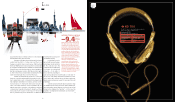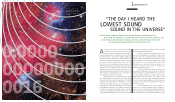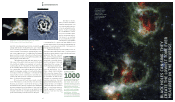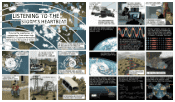Sennheiser 2011 Annual Report Download - page 16
Download and view the complete annual report
Please find page 16 of the 2011 Sennheiser annual report below. You can navigate through the pages in the report by either clicking on the pages listed below, or by using the keyword search tool below to find specific information within the annual report.
30
15 Hz
31
15 Hz
BASS SCHOOL RUBRIK
0,1 Hz
Stuart Matthewman hit the
international music scene
in 1984, when Sade Adu,
the most successful British artist
of all time, made her debut al-
bum Diamond Life. Since then, he
has worked with Sade and her
band as (co-)producer, songwriter, saxophonist and guitar-
ist. Matthewman also performs under the pseudonym Cot-
tonbelly. His latest work, Twin Danger, which he produced,
is soon to be released. In addition, Matthewman composes
film soundtracks. The Englishman has been living in New
York since the mid-80s. We visited him in his small record-
ing studio on the 6th floor of a large office building right in
the middle of Manhattan.
Matthewman: Welcome to my studio. We’re on 29th Street
in Manhattan. Sometimes, you can hear the sirens of police
cars and ambulances. It adds to the vibe of New York City.
Apart from my studio, there are only offices in this build-
ing: management companies and lawyers. I try to keep qui-
et during the day and ratch it up at night. So far, nobody’s
complained. But my music’s good, right? So why would any-
one complain? (Laughs)
Schnell: You’re a Brit - why did you move to New York?
I grew up in Hull, a small town in northern England. In 1980,
I moved to London. I didn’t have any money and moved
from squat to squat. Back then, I was so broke that I was
actually stealing food. Luckily during my first year in Lon-
don, I met Sade and the rest of the band. After we got a re-
cord deal, we were on the road all the time and were often
in New York. I fell in love with the city and stayed on. Every-
thing I need is right here in New York.
The transformation from struggling musician to selling mil-
lions of records as part of Sade’s band went pretty quick.
It was luck and determination. The most important thing as
a musician, or as an artist in general, is to not have a back-
up plan. You have to know what you want. You cannot have
a second job or you will never follow through.
By now, you’ve worked with Sade
for almost 30 years.
We take off for ten years here
and there to do other stuff.
(laughs). We wouldn’t have last-
ed 30 years together if we didn’t
have room to do our own thing.
What other projects are you currently involved in?
I write music for movies. Scoring films has a very different
dynamic from writing songs because you’re writing for
specific scenes to help the audience understand them.
My alter ego, Cottonbelly, dubs music, and produces and
remixes for other artists like Janet Jackson and Gregory
Isaacs. My latest project is called Twin Danger. A jazz proj-
ect (don’t be scared, it’s good!) with an amazing singer
from New York named Vannessa Bley. We’ve got something
very cool going on. That will be happening soon.
Do you use Sennheiser microphones for your productions?
For recording the tom-toms on this drum kit here in the
back, I generally use the Sennheiser MD 421. It sounds
warm and round. For my Saxophone, I use a Sennheiser clip-
on microphone – both live and in the studio. Also, I have
two Neumann KM 184s. They are amazing for drum record-
ings – as overheads on the hi-hat – and they are great for
recording the acoustic guitar. I use them all the time.
Do you record your music in this small studio?
I do. Since it’s so small, I usually use headphones to mix the
music. I don’t trust the sound of this room, but I trust the
sound of the Sennheiser HD 640. They’re great! You hear a
lot of low end and they’re not too bright. You need a very
natural sound for mixing and the HD 640s have a very ac-
curate bass and high end. Also, I love to walk through the
madness of New York or ride on the subway with head-
phones on.
Does Sade record her vocals in this studio?
No, but she also uses Sennheiser equipment. For her vocals
in the studio, she uses the Neumann U 87 Ai. When we play
“I LOVE TO WALK
THROUGH THE MADNESS
OF NEW YORK OR JUST
SIT ON THE SUBWAY.”
1. Cottonbelly sets up
his Sennheiser MD 421
microphone. 2. The
sound of Manhattan sur-
rounds him with every
step he takes.
























